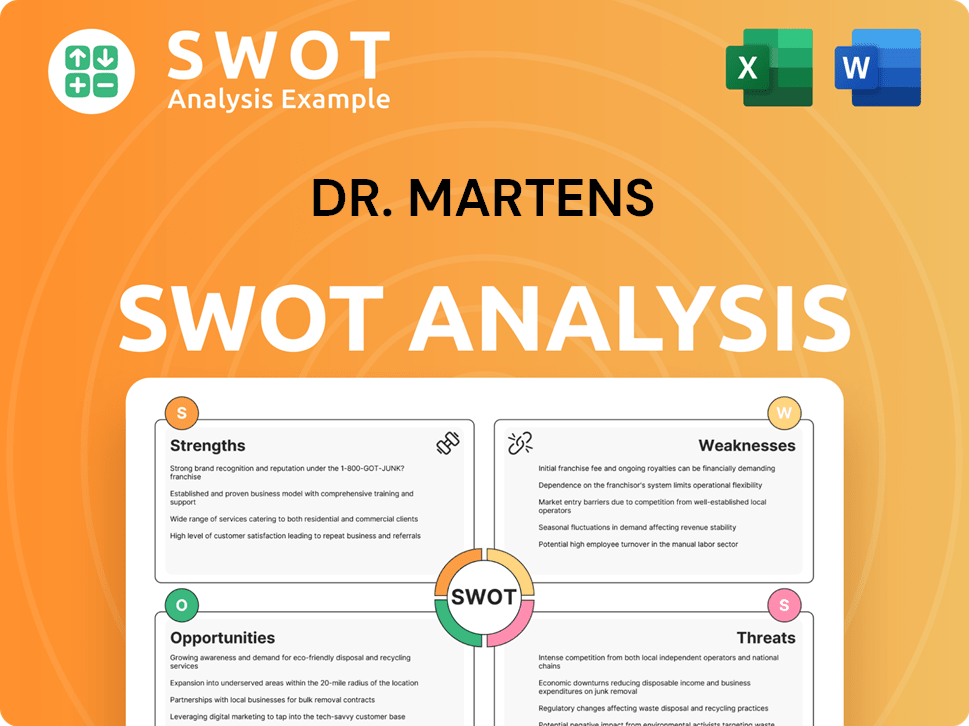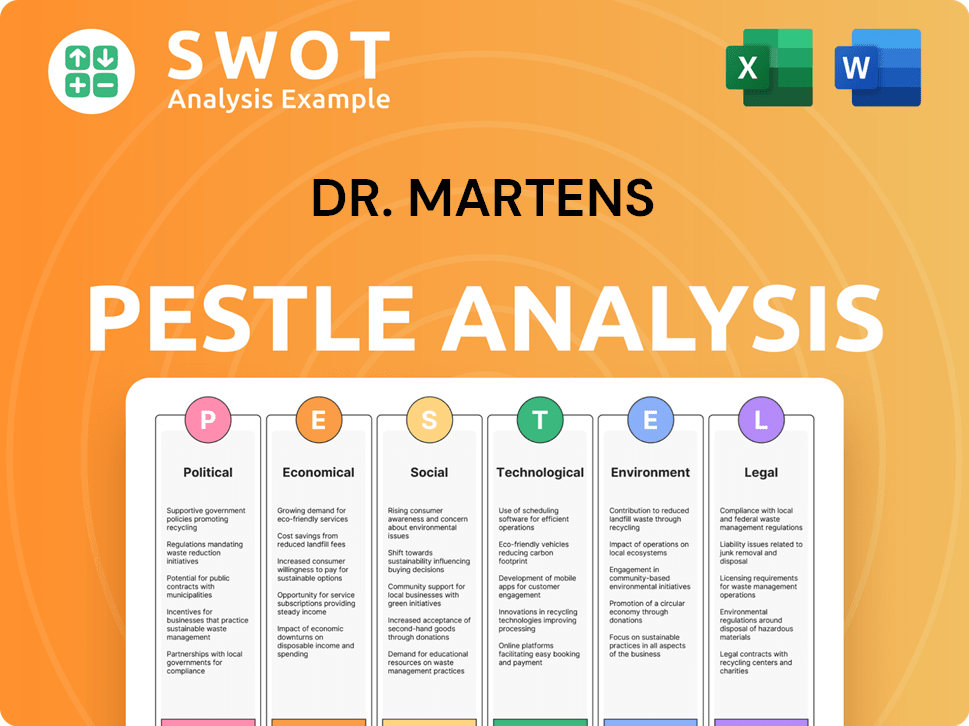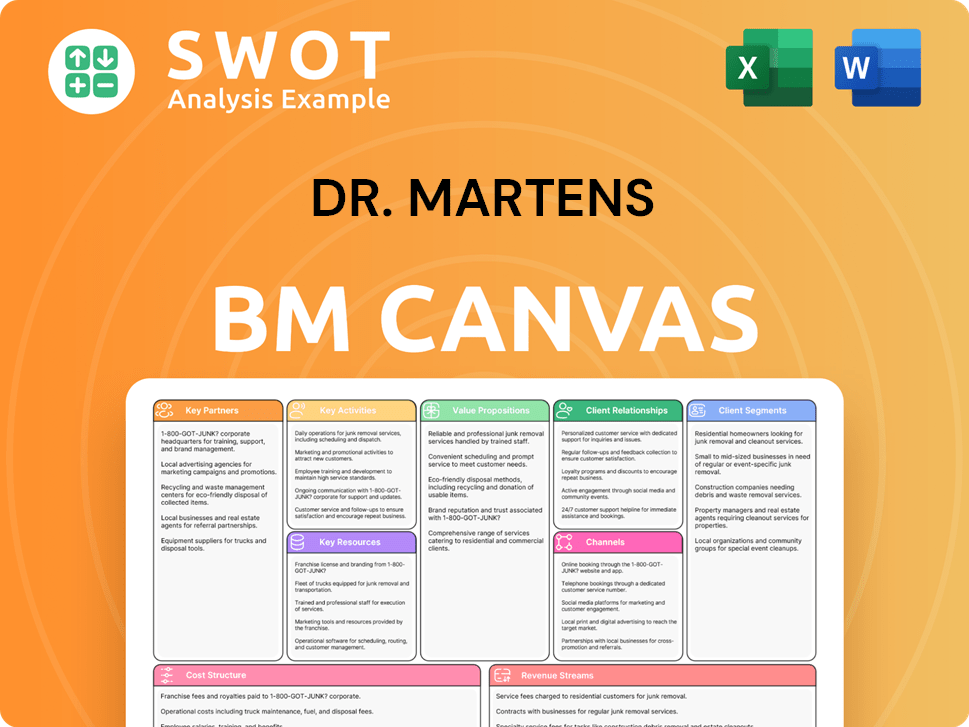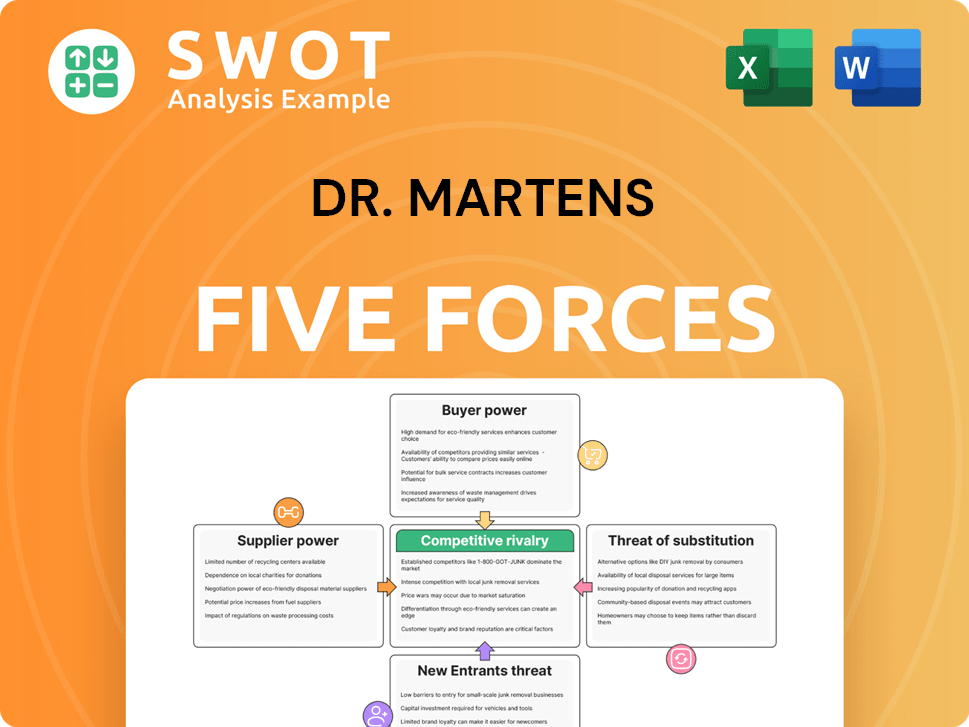Dr. Martens Bundle
How Does the Dr. Martens Company Thrive?
Dr. Martens, a globally recognized footwear icon, isn't just a brand; it's a cultural phenomenon. From its utilitarian roots, the Dr. Martens SWOT Analysis reveals how this iconic boot brand has evolved into a symbol of self-expression, consistently generating substantial revenue, with £972.5 million reported for the fiscal year ending March 31, 2024. This financial success underscores the importance of understanding the inner workings of the Dr. Martens Company.

Delving into the Dr. Martens business model is essential for investors and anyone interested in the footwear industry. The company's strategic market expansion, especially in the Americas and EMEA, alongside its robust direct-to-consumer channels, showcases its adaptability. Understanding the Dr. Martens manufacturing process, its diverse product offerings, and its commitment to its core values will provide a comprehensive view of its enduring appeal and market position. This exploration will uncover how this shoe manufacturer maintains its competitive edge.
What Are the Key Operations Driving Dr. Martens’s Success?
The Dr. Martens Company creates value by designing, manufacturing, and selling footwear, apparel, and accessories. Its core product is the iconic boot, known for its durability, comfort, and distinctive design. The company caters to a global customer base, including fashion-conscious individuals and those seeking practical, long-lasting products.
The company's operations involve a complex global supply chain. Dr. Martens primarily uses third-party factories, mainly in Asia, for manufacturing, which allows for scalability and cost efficiency. Stringent quality control measures are in place to ensure product consistency and uphold the brand's reputation. Efficient logistics and distribution are managed through regional distribution centers.
The value proposition of Dr. Martens is rooted in its brand heritage, product longevity, and cultural significance. The brand's unique selling points include the durability of its products, the comfort provided by its air-cushioned soles, and its strong association with various subcultures and fashion movements over decades. This distinct brand identity fosters strong customer loyalty and differentiates it from competitors.
The manufacturing process of Dr. Martens boots involves several key steps. These include the cutting of leather or synthetic materials, stitching the upper part of the boot, attaching the iconic air-cushioned sole, and adding the distinctive yellow stitching. This process ensures the durability and unique characteristics of each boot. The company's manufacturing process is designed to maintain high-quality standards.
Distribution of Dr. Martens products occurs through a combination of wholesale partnerships, retail stores, and e-commerce platforms. The company operates its own retail locations in major cities worldwide, providing a direct-to-consumer experience. E-commerce sales have grown significantly, with online channels playing a crucial role in reaching a global customer base. The company has a strong retail presence.
Doc Martens has a rich history, originating in the 1960s. The brand has become synonymous with various subcultures, including punk, grunge, and alternative fashion. This association has helped create a strong brand identity and customer loyalty. The brand's cultural significance continues to resonate with consumers.
In recent financial reports, Dr. Martens has shown consistent revenue growth. For example, in the fiscal year ending March 2024, the company reported a revenue of £1.07 billion. The company's ability to maintain profitability while investing in its brand and retail presence is a key factor in its success. You can find more about the ownership and shareholder structure in this article: Owners & Shareholders of Dr. Martens.
The core operational aspects of Dr. Martens include supply chain management, quality control, and distribution. The company relies on a network of third-party manufacturers to produce its products efficiently. Strict quality control measures are implemented throughout the manufacturing process to ensure product consistency and durability. Efficient distribution channels are essential for reaching customers worldwide.
- Supply chain optimization to reduce costs and improve efficiency.
- Emphasis on product durability and quality to maintain brand reputation.
- Strategic retail presence and e-commerce development for market reach.
- Brand marketing and cultural relevance to attract and retain customers.
Dr. Martens SWOT Analysis
- Complete SWOT Breakdown
- Fully Customizable
- Editable in Excel & Word
- Professional Formatting
- Investor-Ready Format

How Does Dr. Martens Make Money?
The Dr. Martens Company, a renowned boot brand, generates revenue through a multifaceted approach. Its financial success hinges on a blend of wholesale, direct-to-consumer (DTC) channels, and e-commerce. This strategy allows the shoe manufacturer to reach a broad customer base while also cultivating direct relationships with its consumers.
For the fiscal year ending March 31, 2024, Dr. Martens reported total revenues of £972.5 million. The company has strategically focused on its DTC channel, which includes both e-commerce and retail stores. This approach enables Dr. Martens to capture higher margins and build direct connections with its customers, shaping its overall financial performance.
Dr. Martens employs a tiered pricing strategy across its product lines. This includes classic styles, seasonal collections, and collaborative editions, catering to various consumer segments and preferences. This diversified approach ensures that Doc Martens can appeal to a wide range of customers, enhancing its market reach and revenue potential.
Dr. Martens utilizes three primary revenue streams: wholesale, direct-to-consumer (DTC) retail, and e-commerce. The DTC channel, comprising both e-commerce and retail stores, has been a strategic focus for growth, allowing the company to capture higher margins and build direct relationships with its customers. The shift towards DTC, particularly e-commerce, reflects a broader industry trend and allows Dr. Martens to better control its brand image, pricing, and customer data. This is a key element of the Marketing Strategy of Dr. Martens.
- Wholesale: Sales to third-party retailers and distributors globally. In fiscal year 2024, wholesale revenue was £350.3 million, a decrease of 5%.
- DTC (E-commerce & Retail): This channel accounted for 64% of total revenue in fiscal year 2024.
- E-commerce: Digital sales offer convenience and accessibility to a global customer base. The company has invested in its online platforms to enhance the customer experience and drive digital growth.
Dr. Martens PESTLE Analysis
- Covers All 6 PESTLE Categories
- No Research Needed – Save Hours of Work
- Built by Experts, Trusted by Consultants
- Instant Download, Ready to Use
- 100% Editable, Fully Customizable

Which Strategic Decisions Have Shaped Dr. Martens’s Business Model?
The evolution of the Dr. Martens Company, often referred to as Doc Martens, showcases significant milestones and strategic shifts that have shaped its market position. The brand's resurgence in the 2000s and 2010s, transitioning from a niche subculture symbol to a mainstream fashion essential, was a pivotal moment. Strategic partnerships and collaborations have kept the brand fresh and introduced it to new audiences.
A key strategic move for Dr. Martens has been its focus on direct-to-consumer (DTC) channels. This includes expanding its owned retail stores and e-commerce presence, which allows for greater control over branding, pricing, and customer experience. This strategy has been reflected in its financial performance, with DTC revenue accounting for 64% of total revenue in fiscal year 2024.
The Dr. Martens Company has navigated operational challenges, including supply chain disruptions and inflationary pressures. In fiscal year 2024, the company reported a 12% decline in profit before tax, partly due to increased operating costs and inventory management issues. Despite these headwinds, the company has responded by optimizing its supply chain and diversifying manufacturing locations.
The brand's revival in the 2000s and 2010s transformed it from a niche icon to a mainstream fashion staple. Strategic collaborations have consistently refreshed its appeal. The focus on direct-to-consumer channels has allowed for greater control over branding and customer experience.
Expanding DTC channels, including retail stores and e-commerce, has been critical. Optimizing the supply chain and diversifying manufacturing locations are key responses to operational challenges. Introducing new styles and collaborations leverages brand equity.
Dr. Martens boasts unparalleled brand strength and heritage, fostering deep emotional connections with consumers. The distinctive design and durability of its products create a loyal customer base. A global distribution network provides extensive market reach.
DTC revenue accounted for 64% of total revenue in fiscal year 2024. The company reported a 12% decline in profit before tax in fiscal year 2024 due to increased costs. The company continues to adapt to new trends.
Dr. Martens's competitive advantages are rooted in its strong brand and heritage, fostering deep consumer connections. The company benefits from economies of scale in sourcing and manufacturing. Its global distribution network, combining wholesale, retail, and e-commerce, provides extensive market reach.
- Brand Strength: Deep emotional connections with consumers.
- Product Design: Distinctive designs and durability.
- Distribution: Global network combining wholesale, retail, and e-commerce.
- Adaptation: Regularly introducing new styles and collaborations.
Dr. Martens Business Model Canvas
- Complete 9-Block Business Model Canvas
- Effortlessly Communicate Your Business Strategy
- Investor-Ready BMC Format
- 100% Editable and Customizable
- Clear and Structured Layout

How Is Dr. Martens Positioning Itself for Continued Success?
The Dr. Martens Company holds a significant position in the global footwear market. The brand is known for its iconic designs and strong customer loyalty, particularly within the premium casual and lifestyle segments. Its competitive advantage stems from a blend of heritage, durability, and fashion appeal, which fosters repeat purchases and a dedicated customer base. The company's presence is global, with major markets in the Americas, EMEA, and APAC regions.
However, the Dr. Martens Company faces several risks. These include shifts in consumer preferences, intense competition, and macroeconomic factors impacting spending. Supply chain disruptions and regulatory changes also pose challenges. Navigating these factors requires strategic adaptation and a focus on operational efficiency to maintain market leadership.
The Dr. Martens brand competes in the premium casual and lifestyle footwear segments. It faces competition from both established global brands and emerging fashion labels. The brand's strong brand identity and loyal customer base contribute to its significant market presence. The company's global reach is extensive, with key markets in the Americas, EMEA, and APAC regions.
The company faces risks from changing consumer preferences and intense competition. Macroeconomic factors, such as inflation and economic downturns, can impact consumer spending. Supply chain disruptions and regulatory changes also pose challenges. These factors can affect production, delivery, and profitability.
The Dr. Martens Company plans to focus on direct-to-consumer growth and e-commerce expansion. Innovation in product design, while maintaining core aesthetics, is ongoing. Opportunities in sustainability and ethical sourcing are also being explored. The company aims to leverage its brand equity and adapt to evolving consumer trends.
In fiscal year 2024, the company reported revenue of £877 million. Direct-to-consumer sales represented 53% of total revenue, highlighting the importance of this channel. The adjusted EBITDA for the year was £166.8 million. The company is focusing on strategies to improve profitability and manage costs effectively. For more details, refer to Growth Strategy of Dr. Martens.
The Dr. Martens Company is implementing several strategic initiatives to drive growth. These include expanding its direct-to-consumer channels, enhancing product innovation, and focusing on sustainability. The company is also working on optimizing its supply chain and improving operational efficiency. These efforts are designed to strengthen the brand's market position and increase profitability.
- Expanding e-commerce platforms.
- Innovating product design.
- Exploring sustainability and ethical sourcing.
- Optimizing supply chain operations.
Dr. Martens Porter's Five Forces Analysis
- Covers All 5 Competitive Forces in Detail
- Structured for Consultants, Students, and Founders
- 100% Editable in Microsoft Word & Excel
- Instant Digital Download – Use Immediately
- Compatible with Mac & PC – Fully Unlocked

Related Blogs
- What are Mission Vision & Core Values of Dr. Martens Company?
- What is Competitive Landscape of Dr. Martens Company?
- What is Growth Strategy and Future Prospects of Dr. Martens Company?
- What is Sales and Marketing Strategy of Dr. Martens Company?
- What is Brief History of Dr. Martens Company?
- Who Owns Dr. Martens Company?
- What is Customer Demographics and Target Market of Dr. Martens Company?
Disclaimer
All information, articles, and product details provided on this website are for general informational and educational purposes only. We do not claim any ownership over, nor do we intend to infringe upon, any trademarks, copyrights, logos, brand names, or other intellectual property mentioned or depicted on this site. Such intellectual property remains the property of its respective owners, and any references here are made solely for identification or informational purposes, without implying any affiliation, endorsement, or partnership.
We make no representations or warranties, express or implied, regarding the accuracy, completeness, or suitability of any content or products presented. Nothing on this website should be construed as legal, tax, investment, financial, medical, or other professional advice. In addition, no part of this site—including articles or product references—constitutes a solicitation, recommendation, endorsement, advertisement, or offer to buy or sell any securities, franchises, or other financial instruments, particularly in jurisdictions where such activity would be unlawful.
All content is of a general nature and may not address the specific circumstances of any individual or entity. It is not a substitute for professional advice or services. Any actions you take based on the information provided here are strictly at your own risk. You accept full responsibility for any decisions or outcomes arising from your use of this website and agree to release us from any liability in connection with your use of, or reliance upon, the content or products found herein.